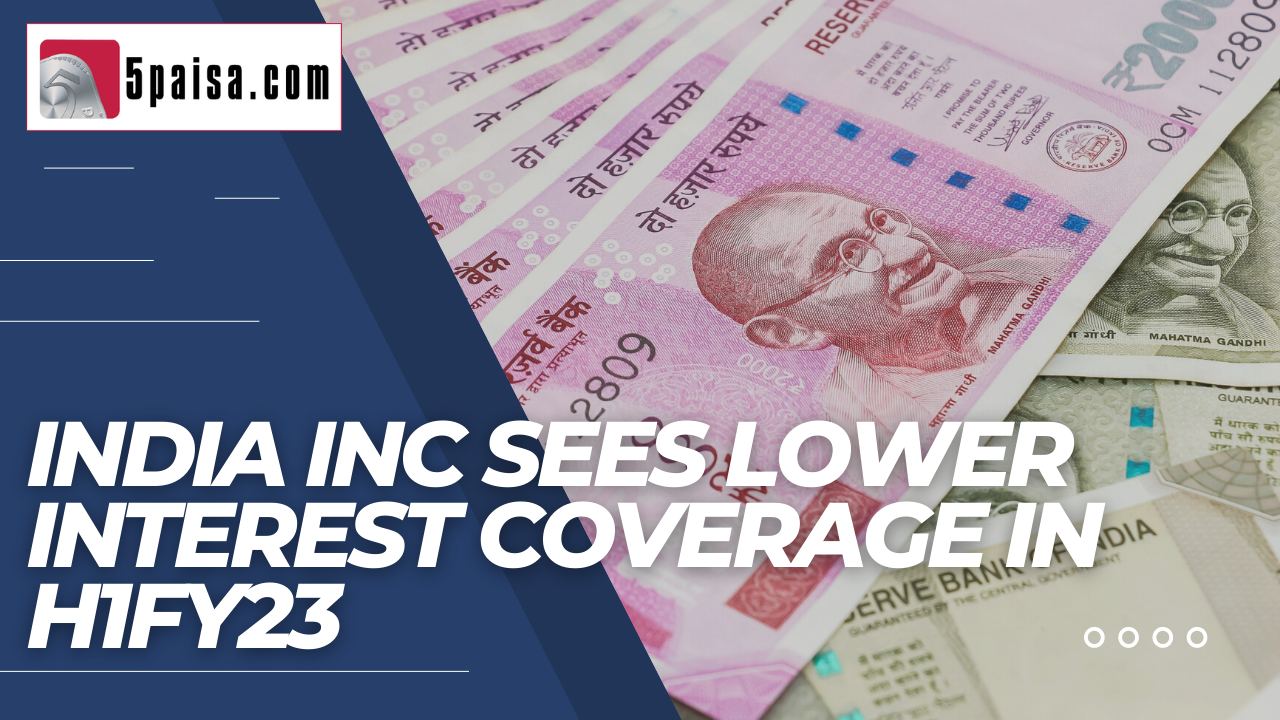India Inc sees lower interest coverage in H1FY23


Since the start of the recently concluded quarter ended September, the RBI had been on a rate hardening spree. It has already hardened rates by 190 bps between May and September raising the raters from 4% to 5.90%. One of the outcomes of this move has been that higher interest rates have been hitting the industrials in a big way in the form of higher interest costs to be borne. Now this has had a direct impact on the interest coverage ratios of the non-financial companies, which has fallen for the first time in the last 3 years But, let us first spend a moment on understanding what is interest coverage ratio and its meaning.
Interest coverage ratio (ICR) is the ratio of the EBIT to the interest cost. It is normally expressed a ratio. For example, an interest coverage ratio of 3.5X means that the EBIT is sufficient to cover the interest cost 3.5 times. Interest coverage is a very important measure of the solvency of the company as it shows whether the company is able to generate enough of core business cash flows to pay the interest on its debt. Normally a higher ICR is considered to be a healthy scenario since it indicates that the company will not have a problem servicing its debt. This quarter, the ICR has fallen for first time in last 3 years.
A total of 2,178 non-financial companies were considered for the study. The concept of ICR does not make sense for a financial like a bank or an NBFC, since borrowing cost and lending cost are the input and output for them. For them interesting cost and interest income is the core business. For industrials, interest cost is a choice that arises from opting for debt as a means of resource raising. Hence ICR is more relevant to the industrial companies since they need to measure the solvency. The fall in the ICR in the latest quarter has exactly coincided with the RBI hiking rates consistently, resulting in higher cost of funds for the corporates.
The interest coverage ratio (ICR) had touched a 11 year high of 7.1X in the September 2021 quarter. That was a dual impact of low interest rates and substantial deleveraging done by most of the largest Indian companies. However, with the rates rising consistently in the last few months, the interest coverage has dropped from 7.1X to 6.1X on a yoy basis. While fall in ICR shows reduced ability to service interest on debt, it must be noted that in isolation, even an ICR of 6.1X is extremely healthy and should hardly be a cause for concern at this point of time. Hopefully, as rates taper, this ratio should also become more attractive.
The lower ICR was also reflected in the form of lower net profits. For instance, if you consider the first half of fiscal year FY23, then the net profits of all non-financial companies is actually down 12% yoy since the interest costs are up nearly 14% on a yoy basis. Clearly, the rising interest cost has taken its toll on the interest coverage, the solvency levels and on the net profits of non-financial companies in India. In the Indian context, the transmission to lending rates is almost immediate and hence there is no time lag between the RBI hiking the repo rates and the industry feeling the pinch of higher rates. Input costs added to the stress.
If one were to break up the impact of the fall in ICR, the impact was much higher on the large cap companies than on mid cap companies due to the size of debt taken. For instance, the median interest coverage ratio of larger firms with revenues of more than Rs20,000 crore per year, fell by 120 bps from 12.3% to 11.5% but for smaller companies the ICR was actually higher. That is because large caps have to operate at a scale and are also dependent on exports, which is under strain amid global demand constraints. On the ICR front, the small caps have done better.
Which were the sectors that bore the brunt. For instance, the more capital intensive sectors like metals, oil & gas had a sharp depletion in the interest coverage ratio since their sales were largely export driven and it became a kind of double whammy for them. The impact of ICR depletion was less severe in sectors like consumer durables, hospitality and pharma companies, which are the less leveraged sectors.
Share Market Today
| Indices Name | Price | Price Change (% change) |
|---|---|---|
| S&P ASX 200 | 7555.70 | -82.4 (-1.08%) |
| CAC 40 | 8022.41 | -0.85 (-0.01%) |
| DAX | 17737.36 | -100.04 (-0.56%) |
| Dow Jones | 37986.40 | 211.02 (0.56%) |
| FTSE 100 | 7895.22 | 12.39 (0.16%) |
| Hang Seng | 16224.15 | -161.73 (-0.99%) |
| US Tech Composite | 15287.01 | -319.49 (-2.05%) |
| Nikkei 225 | 37068.28 | -1011.35 (-2.66%) |
| S&P 500 | 4967.23 | -43.89 (-0.88%) |
| Gift Nifty | 22203.50 | 188.5 (0.86%) |
| Shanghai Composite | 3065.26 | -8.96 (-0.29%) |
| Taiwan Weighted | 19527.12 | -774.08 (-3.81%) |
| US 30 | 37973.70 | 209.7 (0.56%) |
Start Investing in 5 mins*
Rs. 20 Flat Per Order | 0% Brokerage
